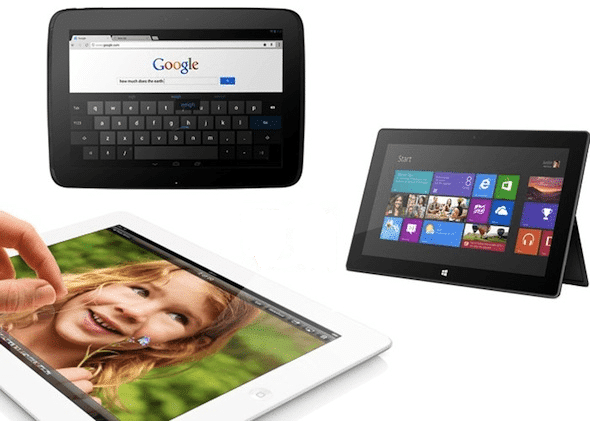There were at least three launches that have grabbed users’ attention this year. Incidentally, it also involves the great guns of the technology world. The products that they launched are in the same category and that the war for supremacy has reached its zenith is fully evident. Of the three, Google it may be recalled was the only giant not directly involved in the computer industry. The other two are known to fight each other out ferociously, and that too cannot be denied. Now the battle is reduced between Apple’s recent launch iPad, Microsoft’s tablet named Surface and Google’s 10 inch named Nexus 10.

It may be a long war for the three, and all indications are that it is going to be a bitter one at that. However, who emerges the victor will not be clear, and at what cost either. Of course, the possibility of more launches in the next year correcting some changes or shortcomings can also be expected. It appears the battle will continue leading to full fledged war. Consumers, no doubt will glee at the prospect of more improvements coming in the wake of this intense competition, market watchers say.
In the wake of much talk about these devices rivaling computers, making a comparison between them is inevitable. Rumor mills apart, each have their own set of pros and cons. Feature-wise too, making comparison is proving to be little difficult because of the way in which each manufacturer is trying to position themselves in the battle for supremacy. Here are the highlights of their respective products.
iPad 4 versus Microsoft Surface versus Nexus 10
Apple iPad: It should not be forgotten that Apple was the first to invent the concept of a tablet and the other two simply followed in its footsteps. As a result, Apple has a bigger share of the total market, although their product seems to be priced a little higher than others. In fact, Apple’s share in sales is reputed to be much bigger than the combined sales of its immediate competitors.
A major advantage for iPad is their Apple Store with an unrivaled collection of apps for downloading. Another feature in the iPad that needs to be looked at is the absence of any standard connectors like micro USB or HDMI port connectivity. It can mean that Apple will not connect to standard devices and should you need connectivity the only recourse is to go for their proprietary accessories.
Microsoft Surface: The biggest advantage of this tablet is that it leverages the advantages inherent to the Windows 8 Platform. The familiarity of the platform, it is expected can possibly mean a big swing from other iPad like device users.
The notable advantage that Surface sure will take advantage of is the standard accessories that they use for providing inter-connectivity to other display peripherals. Another advantage is it can run Photoshop and Visual Studio giving it that extra punch. A weak point however, is the smaller number of apps they have. However, the chances of increasing this are very bright.
Google Nexus 7: By all indications the Nexus 7 is a potentially powerful candidate pitted against Apple’s iPad. If price is going to be a deciding factor in the future, then Apple will need to take a second thought on how they are going to price their products.
Nexus 7 is 10 inches and indeed has some though provoking designs to its credit, but competition might slow down its progress. That it’s rated as one of the best Android Tablets is something that will cheer up its marketing forces doubtlessly. That it is very much like an iPad sans some features can work negatively. However, for those who plan to use it primarily for watching videos and reading books, there cannot be anything better in this price range.
